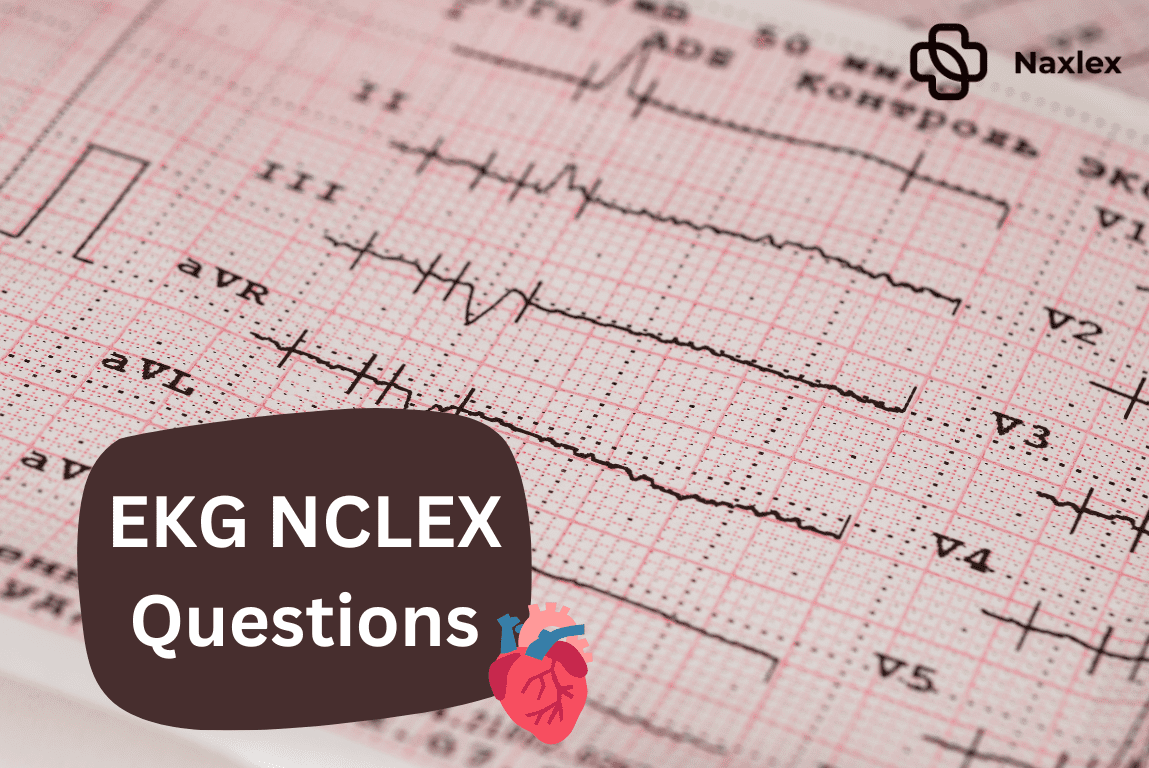Free NCLEX 14-day Free Trial
Try some exam questions on the NCLEX!
EKG NCLEX Questions
Electrocardiograms, called EKG or ECG, are vital diagnostic instruments for scrutinizing and understanding cardiac rhythms, conduction irregularities, and heart ischemia. Additionally, you use them to assess the extent of various cardiac conditions, such as cardiomyopathy, pericarditis, heart disease, and hypertension. Learn more about EKG NCLEX Questions.
The EKG NCLEX questions will test your understanding of this diagnostic instrument, sinus bradycardia, causes of the rhythm, and treatment. Naxlex NCLEX offers study materials that will help you tackle EKG NCLEX questions. We boast prep materials such as Naxlex NCLEX flashcards, EKG NCLEX questions test banks, and free Naxlex NCLEX practice tests.
At Naxlex NCLEX, tutors do their best to ensure they provide you with 100% accurate and in-depth NCLEX study guides covering all areas from which exams may come. We also offer live tutoring classes for students who want to polish up EKG NCLEX. So contact the Naxlex NCLEX team today and enjoy our packages, which consist of the following:
- Over 5,000 EKG NCLEX questions test bank that is regularly updated
- Live tutoring sessions
- EKG NCLEX practice questions
- 100% money-back guarantee
- Naxlex NCLEX EKG NCLEX study guide

Steps to Reading EKG Rhythms
Deciphering EKGs can pose a challenge, particularly for those lacking formal training. However, it has become a routine task for nurses and clinicians in their daily practice. Electrocardiograms depict waves that mirror the depolarization and contraction of different heart segments.
The EKG display exhibits multiple waves, typically denoted as PQRST. The P-wave represents a trial depolarization and contraction, the QRS-wave indicates ventricular contraction, and the T-wave illustrates ventricular relaxation and repolarization.
For interpreting EKGs, a systematic five-step approach can be employed to evaluate a patient's cardiac status:
- Calculate sinus rate
To calculate the sinus rate, tally the number of R peaks and multiply the count by ten. This calculation provides the beats per minute, considering that the monitor typically shows only a brief snapshot of electrical activity.
In interpreting these findings, it's crucial to understand that the normal sinus rhythm (NSR) typically results in 60–100 beats per minute. A rate slower than 60 bpm is termed normal sinus bradycardia, while a rate exceeding 100 bpm is categorized as normal sinus tachycardia.
- Assess the rhythm
The rhythm should display consistent and evenly spaced intervals between peaks. When there are irregular gaps between pulses, it may indicate an arrhythmia in the patient. In such cases, it's essential to thoroughly examine all waves, paying close attention to the presence and regularity of both the P and QRS waves.
- Assess the P-wave
Evaluate whether the P-wave appears typical, which becomes more intuitive with experience. Deviations in the P-wave may indicate issues with atrial depolarization. Normally, the duration of the P-wave should be less than 0.12 seconds.
- Assess PR interval
The PR interval encompasses the P-wave and the PR segment, measured from the start of the P-wave to onset of the QRS complex. A typical PR interval spans less than five small boxes on the EKG paper, corresponding to 0.12-0.20 seconds. Shorter PR intervals occur with higher heart rates, indicating a sympathetic-driven enhancement of AV nodal conduction. A shortened PR interval might indicate Wolff-Parkinson-White syndrome, while a prolonged PR interval could signify AV node blockage.
- Assess QRS complex
This denotes the duration of ventricular depolarization and contraction. The QRS duration typically ranges from 0.06 to 0.10 seconds and remains unaffected by heart rate variations. Elevated voltage levels may suggest hypertrophy of the left or right ventricle.
EKG NCLEX questions from Naxlex NCLEX test bank
- During an EKG assessment, the nurse observes a shortened PR interval. What condition should the nurse be particularly concerned about?
B) Sinus bradycardia
C) Ventricular fibrillation
D) Wolff-Parkinson-White syndrome
Answer: D) Wolff-Parkinson-White syndrome
Explanation: A shortened PR interval may indicate an accessory pathway between the atria and ventricles, characteristic of Wolff-Parkinson-White syndrome. This pathway bypasses the normal AV node, resulting in a shortened PR interval and a characteristic delta wave. Options A, B, and C are associated with different EKG findings and clinical conditions.
- A patient's heart rhythm exhibits a regular pattern with a heart rate of 40 beats per minute and a narrow QRS complex. Which of these conditions could be consistent with this presentation? (Select all that apply)
A) Sinus bradycardia
B) Third-degree heart block
C) Ventricular tachycardia
D) Hypothermia
Correct answers: A) Sinus bradycardia and D) Hypothermia
Explanation: Sinus bradycardia is characterized by a slow heart rate (less than 60 beats per minute) with regular P waves preceding each QRS complex. Hypothermia can also cause bradycardia and a slow heart rate. Third-degree heart block typically presents with an irregular rhythm, and ventricular tachycardia is associated with a fast heart rate and widened QRS complexes.
- A patient's EKG reveals a PR interval of 0.14 seconds and a widened QRS complex. Which of the following conditions could explain these findings? (Select all that apply)
A) Atrial fibrillation
B) Right bundle branch block
C) Hyperkalemia
D) First-degree heart block
Correct answers: B) Right bundle branch block and C) Hyperkalemia
Explanation: Right bundle branch block (RBBB) can cause a widened QRS complex, while hyperkalemia can also lead to widened QRS complexes. Atrial fibrillation typically presents with irregularly irregular heart rhythms, and first-degree heart block is characterized by a prolonged PR interval, not a widened QRS complex.
For more Naxlex NCLEX EKG NCLEX questions, click here
Winding Up
Do you want help with your EKG NCLEX questions? The Naxlex NCLEX system has helped over a million students pass their NCLEX, reduce long hours of studying, and ensure they don't just cram but understand all nursing concepts. At Naxlex NCLEX, we offer more EKG NCLEX video tutorials covering the highly tested areas in the topic section. We also offer A comprehensive study guide on EKG NCLEX questions and every section covered on NCLEX.
Naxlex NCLEX offers free EKG NCLEX practice questions, electronic flashcards, and live tutoring. So, to refresh your knowledge of basic cardiac conditions and heart anatomy, proceed to the EKG. Contact us today, and we have everything you need. We offer our members a 100% money-back guarantee if they pass our tests and fail the NCLEX exam. Contact our team today and start your NCLEX passing journey.
Naxlex NCLEXPre-register for our Upcoming NCLEX Program. The top and most trusted Nclex prep that's accurate as the actual exam.
- Content Created by over 600 nursing students who have sat for NCLEX. (in person)
- Reviewing over 3000 Flawless responses shared by NCLEX exam takers
- Creating questions from the most tested areas to exact repeated questions
- Creating a study guide on most common tested areas
- Over 3000 Qbanks with well explained rationale, with our approach focusing on sata, priority questions and NGN questions.
- Easy to use interface, unlimited CATs just like NCLEX, unlimited readiness tests.
- Sure pass guarantee on first time.
Turn on notifications and get daily updates on when we shall be going live.

